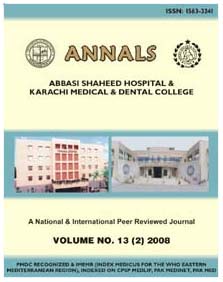
| |
| Home |
| Editorial Staff |
| Instruction to Authors |
| Journal-Issues |
| Policy |
| Copyright |
| MICROPATHOGENS IN CHRONIC SUPPURATIVE OTITIS MEDIA AN EXPERIENCE OF 208 PUS CULTURES AT ABBASI SHAHEED HOSPITAL
MUHAMMAD AYUB MUSANI, GULNAZ KHALID, ABBAS ZAFAR, TAHIRA MANSOOR, SAEED AHMED SHEIKH ABSTRACT Objective: To determine the causative pathogens of chronic suppurative otitis media and their antimicrobial sensitivity. Study Design: Prospective analytic study. Materials and Methods: Two hundreds patients were enrolled for the study attending the ENT out patient department of Karachi Medical & Dental College and Abbasi Shaheed Hospital. Majority of the patients were children and young adult, with male predilection. 208 Pus cultures were taken from the ears of the 175 selected patients and Gram staining and antibiotic sensitivity was done on all of them. Results: Staphlococcus aureus and Pseudomonas aeruginosa were responsible for most of infections in this study about 68%. Proteus spp., Klebsiella spp. and E.coli were also found in the cultures but in very low figure. Quinolones and aminoglycosides were found extremely effective against the two major pathogens, i.e., Staph.aureus and Pseudomonas aeruginosa with sensitivity index of 91 % and 98% respectively. Macrolides and cephalosporins were also highly effective with 80-88% sensitivity whereas both Staph.aureue and Pseudomonas were quite resistant to Ampicillin and Amoxicillin. Conclusion: Chronic suppurative otitis media is primarily the disease of children and young adults, and incidence in adult and old population being very less. Staphylococcus aureus and Pseudomonas aeruginosa are most frequent causative organism and extremely sensitive to quinolones and aminoglycosides.
|
For Full text contact to: |
